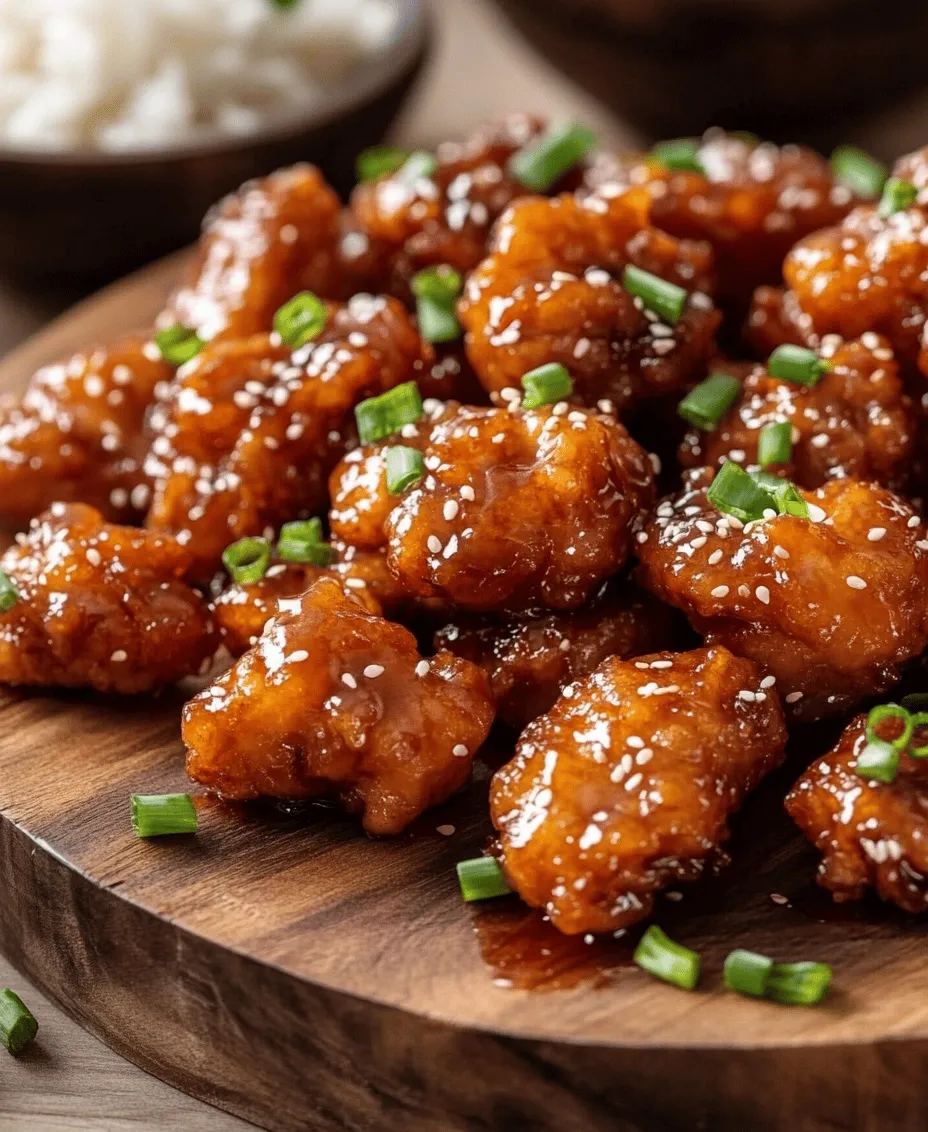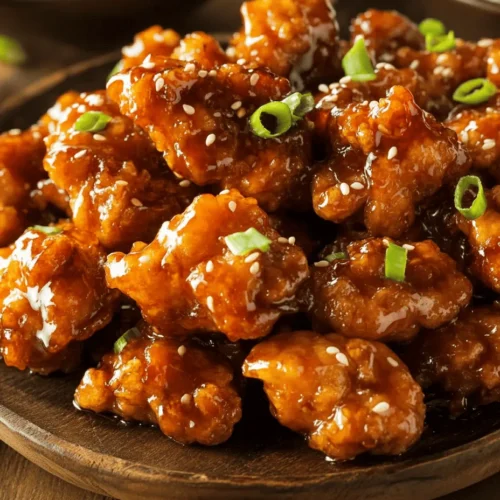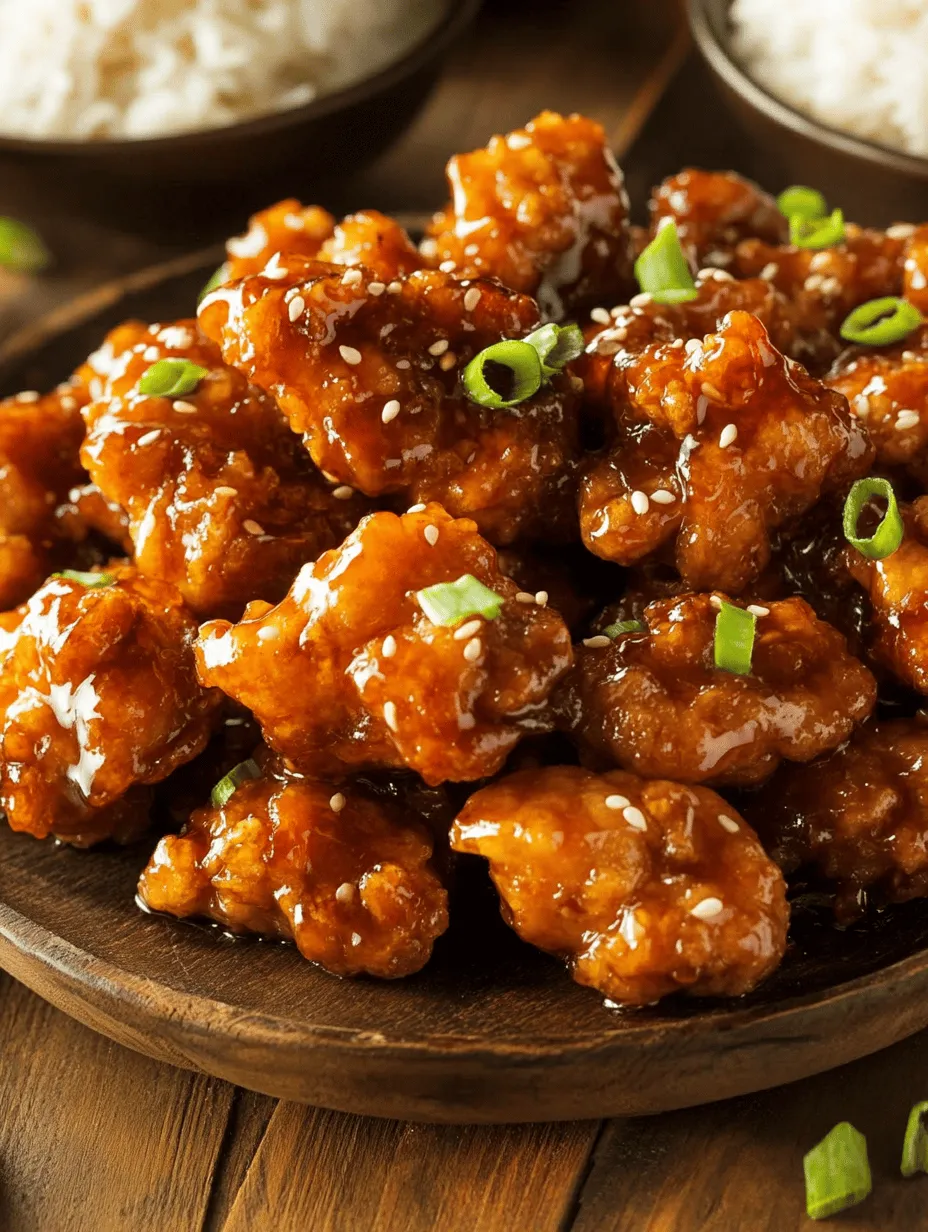Crispy Chinese Honey Garlic Chicken is a dish that perfectly embodies the balance of flavors in Chinese cuisine. The dish marries the sweetness of honey with the savory depth of soy sauce, all while being enhanced by the aromatic notes of garlic and ginger. With its crispy coating and succulent chicken, this recipe is not only a delightful treat but also a dish that can easily impress family and friends during any mealtime. Whether you are looking for a quick weeknight dinner or a special occasion dish, this recipe is sure to elevate your dining experience.
In this article, we will delve into the key ingredients that make this dish stand out, provide step-by-step instructions on how to prepare the chicken, and explore the cultural significance behind this beloved recipe. By the end, you’ll be well-equipped to recreate this restaurant-quality meal right in your own kitchen.
Understanding the Ingredients
Key Components of the Chicken
Boneless Chicken Thighs
When it comes to making crispy chicken, the choice of meat can significantly affect the outcome of the dish. In this recipe, we recommend using boneless chicken thighs instead of chicken breasts for several compelling reasons.
First and foremost, chicken thighs are known for their higher fat content, which contributes to a more moist and flavorful dish. Unlike chicken breasts that can easily dry out, thighs maintain their juiciness even after cooking. This extra moisture is essential, especially when frying or baking, as it ensures that the chicken remains tender and succulent.
Additionally, the rich flavor profile of chicken thighs complements the honey garlic sauce beautifully, creating a harmonious blend of tastes. The combination of crispy skin and juicy meat makes for a texture that is not only enjoyable but also satisfying.
Coating Mixture
The crispy coating is what sets this dish apart from other chicken recipes. The coating mixture typically consists of all-purpose flour, cornstarch, and a mix of seasonings. Each ingredient plays a vital role in achieving the desired texture and flavor.
– All-Purpose Flour: This is the primary coating ingredient, providing the base for the crispiness. The flour forms a protective layer around the chicken, allowing it to fry to a golden brown while sealing in moisture.
– Cornstarch: Adding cornstarch to the coating mixture is a game-changer. Cornstarch is known for its ability to create a light and crispy texture, which is essential for achieving that perfect crunch. It absorbs moisture during frying, preventing the coating from becoming soggy.
– Seasonings: Commonly used seasonings, such as garlic powder, onion powder, and a pinch of salt and pepper, enhance the flavor of the coating. These simple additions ensure that every bite is packed with taste.
The Honey Garlic Sauce
Flavor Profile
The heart of this dish lies in its honey garlic sauce, which is an exquisite blend of several key ingredients. Each component contributes to a complex flavor profile that is both sweet and savory.
– Honey: The star of the sauce, honey provides a natural sweetness that balances the savory elements. It also caramelizes beautifully when cooked, creating a rich glaze that clings to the chicken.
– Soy Sauce: This fermented sauce adds depth and umami to the dish. The saltiness of soy sauce enhances the overall flavor, creating a delightful contrast to the sweetness of the honey.
– Garlic and Ginger: These aromatic ingredients are essential in Chinese cuisine. Garlic offers a pungent, savory note while ginger adds a fresh, zesty kick. Together, they create a fragrant aroma that elevates the dish.
Thickening Agent
To achieve the perfect consistency for the honey garlic sauce, cornstarch is again utilized, but this time as a thickening agent. By creating a cornstarch slurry, you can easily adjust the thickness of the sauce to your preference. This technique not only helps to prevent the sauce from being too runny but also allows it to adhere better to the crispy chicken, ensuring that each piece is coated in flavorful goodness.
Preparing the Chicken
Step-by-Step Instructions to Prepare the Chicken
Now that we have a solid understanding of the ingredients, let’s dive into the preparation of the chicken itself, ensuring that we achieve that perfect crispy texture.
Mixing the Coating
1. Combine Dry Ingredients: Start by preparing the coating mixture. In a large bowl, combine 1 cup of all-purpose flour, 1/2 cup of cornstarch, and the seasonings of your choice. A good starting point is 1 teaspoon of garlic powder, 1 teaspoon of onion powder, and salt and pepper to taste. Mix the dry ingredients thoroughly to ensure even distribution of flavors.
2. Prepare the Egg Wash: In a separate bowl, crack 2 large eggs and whisk them until well combined. The egg wash acts as the adhesive for the coating, helping it stick to the chicken pieces.
Coating Technique
3. Prepare the Chicken: Take your boneless chicken thighs and cut them into bite-sized pieces, typically around 1-2 inches in size. This size ensures even cooking and allows for a good balance of crispy coating to tender chicken.
4. Coating the Chicken: Begin by dipping each piece of chicken into the egg wash, allowing any excess to drip off. Next, transfer the chicken to the coating mixture, ensuring each piece is thoroughly coated. For maximum crispiness, press down gently on the chicken pieces to ensure the coating adheres well. Set the coated chicken aside on a plate while you prepare your frying method.
Safety and Hygiene Considerations
When handling raw chicken, it is crucial to practice proper food safety to avoid any risk of cross-contamination. Here are some essential tips to keep in mind:
– Wash Your Hands: Always wash your hands thoroughly with soap and water before and after handling raw chicken. This prevents the spread of harmful bacteria.
– Clean Surfaces: Use hot, soapy water to clean all surfaces that come into contact with raw chicken, including cutting boards, utensils, and countertops.
– Use Separate Utensils: Designate specific utensils for raw chicken to prevent cross-contamination with other food items.
By adhering to these hygiene practices, you ensure that your cooking process is safe and enjoyable.
Crafting the Honey Garlic Sauce
With the chicken prepared and coated, it’s time to move on to the sauce that will bring this dish to life.
Cooking the Sauce
1. Simmering Techniques: Begin by heating a small saucepan over medium heat. Add 1/2 cup of honey, 1/4 cup of soy sauce, 3 minced garlic cloves, and 1 tablespoon of freshly grated ginger. Allow the mixture to come to a gentle simmer. The key here is to avoid boiling the sauce vigorously, as this can cause the garlic to burn and impart a bitter flavor.
2. Creating the Slurry: In a separate bowl, mix 2 tablespoons of cornstarch with 2 tablespoons of cold water to create a slurry. Once the sauce is simmering, slowly whisk the cornstarch slurry into the saucepan. Continue to stir until the sauce thickens to your desired consistency. This process should only take a few minutes.
3. Final Touches: Once the sauce has thickened, remove it from the heat and set it aside. It will be ready to coat the crispy chicken once it has finished cooking.
By following these detailed steps, you’ll be well on your way to creating a delicious batch of Crispy Chinese Honey Garlic Chicken. In the next part of this article, we’ll delve into the frying process, tips for achieving the perfect crispiness, and serving suggestions to make this dish truly unforgettable. Stay tuned for the continuation of this culinary journey that promises to bring restaurant-quality flavors into your home kitchen.

Flavor Adjustments
Personalizing the Sauce
When it comes to the honey garlic sauce for your crispy chicken, customization can take your dish from good to extraordinary. The beauty of this recipe lies in its versatility, allowing you to tweak the flavors to suit your palate.
– Adjusting Sweetness: If you prefer a sweeter sauce, consider adding more honey, incrementally, until it reaches the desired level of sweetness. Conversely, if you wish to tone down the sweetness, you can add a splash of soy sauce or a dash of vinegar, which will help balance the flavors without overwhelming the dish.
– Modifying Saltiness: The soy sauce contributes saltiness to the dish, but you can adjust this based on your preference. If you’re watching your sodium intake, opt for low-sodium soy sauce. For an added twist, consider using tamari or coconut aminos if you’re looking for gluten-free or soy-free options. These alternatives can introduce unique flavors while keeping the essence of the dish intact.
– Exploring Other Flavors: For a hint of heat, you might want to add a pinch of red pepper flakes or a drizzle of sriracha to your sauce. Similarly, adding fresh ginger or garlic can enhance the overall flavor profile, making the sauce even more aromatic and complex.
Frying the Chicken
The Frying Process
Frying your chicken to perfection is an essential step in achieving that coveted crispy texture. Here’s how to get it right.
– Oil Temperature Control: Maintaining the correct oil temperature is crucial for frying. If the oil is too cool, the chicken will absorb too much oil and become greasy rather than crispy. Conversely, if the oil is too hot, the exterior may char before the chicken cooks through. Ideally, aim for a temperature of about 350°F (175°C). Using a thermometer can help ensure accuracy, but you can also test the oil by dropping a small piece of chicken into it; if it sizzles vigorously, you’re ready to fry.
– Batch Cooking: For best results, fry the chicken in batches. Crowding the pan can lower the oil temperature and lead to steaming the chicken instead of frying it. About 4-6 pieces at a time is a good rule of thumb, depending on the size of your frying pan. Fry each batch for about 4-5 minutes or until golden brown and cooked through. After frying, place the chicken on a wire rack over a baking sheet to keep it crisp and allow excess oil to drain.
Final Touches and Presentation
Draining and Coating
Once your chicken is fried to a golden perfection, it’s time to make sure it stays crispy and is beautifully coated.
– Draining Excess Oil: After frying, it’s important to drain the chicken properly. Instead of placing it directly on a plate, which can trap steam and moisture, transfer the chicken onto a wire rack. This allows air to circulate around the chicken, keeping it crispy as it cools.
– Coating in Sauce: For the perfect honey garlic coating, transfer your fried chicken into a large bowl and pour the sauce over it while it’s still hot. Toss gently but thoroughly to ensure each piece is evenly coated. This method allows the sauce to cling to the chicken without making it soggy.
Serving Suggestions
Presentation plays a vital role in the dining experience. Here’s how to elevate your dish:
– Presentation Ideas: Garnish your crispy honey garlic chicken with thinly sliced green onions and a sprinkle of sesame seeds. This not only adds a pop of color but also enhances the flavor with a hint of freshness and nuttiness. You can also add a few cilantro leaves for an additional layer of flavor and vibrancy.
– Complementary Side Dishes: To create a well-rounded meal, consider serving your chicken alongside steamed jasmine rice, which absorbs the sauce beautifully and balances out the sweetness. Alternatively, stir-fried vegetables or noodles tossed in a light soy sauce can complement the dish perfectly, adding both texture and nutrition.
Cultural Context and Popularity
The Appeal of Honey Garlic Chicken
Understanding the origins and cultural significance of honey garlic chicken can deepen your appreciation for this dish.
– Cultural Significance: Honey garlic chicken has roots in Chinese cuisine, where the balance of flavors is key. The use of honey and garlic reflects traditional Chinese cooking principles, which focus on harmonizing sweet and savory elements. This dish has transcended its origins, making its way into Western cuisine and adapting to local tastes.
– Popularity in Restaurants: This dish has earned its place on menus in Chinese restaurants worldwide, often because of its universal appeal. The combination of crispy chicken and a sweet, sticky sauce resonates with many diners, appealing to those who enjoy comfort food. Its popularity is also attributed to its visually appealing presentation and the satisfying crunch that accompanies each bite.
Conclusion
Crispy Chinese Honey Garlic Chicken is more than just a dish; it embodies a delightful fusion of flavors and techniques that reflect both cultural heritage and modern culinary creativity. With its perfect balance of sweetness and savory notes, this recipe is sure to impress family and friends alike. By following the detailed steps outlined above, you can create a delicious, crispy chicken dish that rivals any restaurant offering, bringing the taste of Chinese cuisine right into your home.
Whether enjoyed as a main course or served at a gathering, this dish offers a culinary experience that is both satisfying and memorable. So roll up your sleeves, gather your ingredients, and embark on this delicious cooking journey. Enjoy every bite of your homemade honey garlic chicken, and share the joy of this delightful dish with loved ones.



